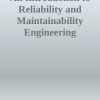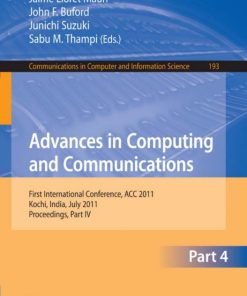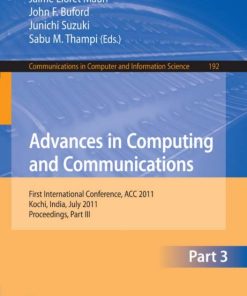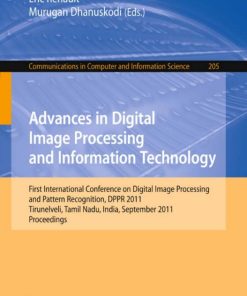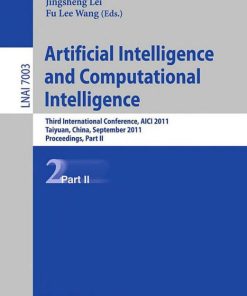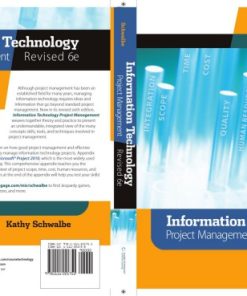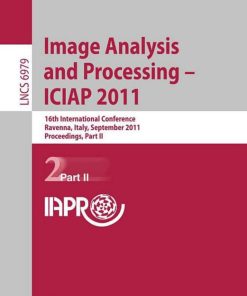Advances in Computing and Communications Part II First International Conference ACC 2011 Kochi India July 22 24 2011 Proceedings 1st edition by Ajith Abraham, Jaime Lloret Mauri, John Buford 9783642227141 3642227147
$50.00 Original price was: $50.00.$25.00Current price is: $25.00.
Authors:Ajith Abraham; Jaime Lloret Mauri; John Buford; Junichi Suzuki; Sabu M. Thampi , Series:IT & Computer [177] , Tags:Computers; Networking; Hardware; Information Technology; Intelligence (AI) & Semantics; Programming; Algorithms; System Administration; Storage & Retrieval; Software Development & Engineering; General; Springer 2011 , Author sort:Abraham, Ajith & Mauri, Jaime Lloret & Buford, John & Suzuki, Junichi & Thampi, Sabu M. , Ids:Google; 9783642227134 , Languages:Languages:eng , Published:Published:Jul 2011 , Publisher:Springer Science & Business Media , Comments:Comments:This volume is the second part of a four-volume set (CCIS 190, CCIS 191, CCIS 192, CCIS 193), which constitutes the refereed proceedings of the First International Conference on Computing and Communications, ACC 2011, held in Kochi, India, in July 2011.The 72 revised full papers presented in this volume were carefully reviewed and selected from a large number of submissions. The papers are organized in topical sections on database and information systems; distributed software development; human computer interaction and interface; ICT; internet and Web computing; mobile computing; multi agent systems; multimedia and video systems; parallel and distributed algorithms; security, trust and privacy.
Advances in Computing and Communications Part II First International Conference ACC 2011 Kochi India July 22 24 2011 Proceedings 1st edition by Ajith Abraham, Jaime Lloret Mauri, John Buford – Ebook PDF Instant Download/Delivery. 9783642227141, 3642227147
Full download Advances in Computing and Communications Part II First International Conference ACC 2011 Kochi India July 22 24 2011 Proceedings 1st edition after payment
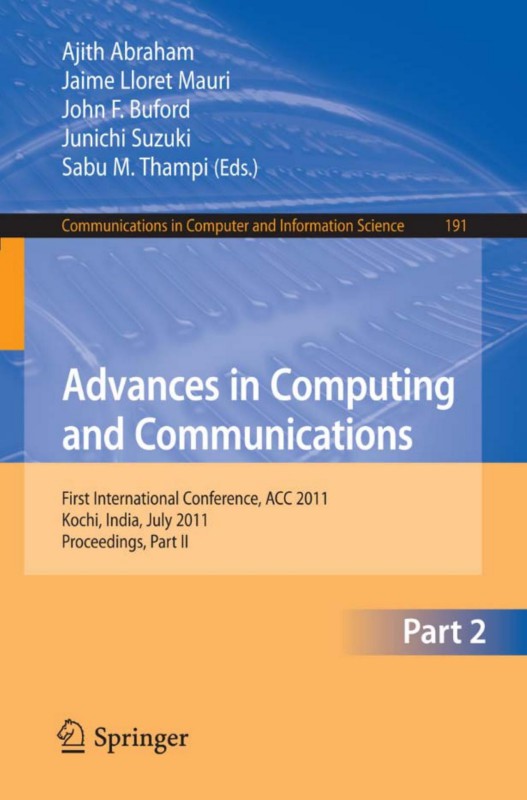
Product details:
ISBN 10: 3642227147
ISBN 13: 9783642227141
Author: Ajith Abraham; Jaime Lloret Mauri; John Buford
This volume is the second part of a four-volume set (CCIS 190, CCIS 191, CCIS 192, CCIS 193), which constitutes the refereed proceedings of the First International Conference on Computing and Communications, ACC 2011, held in Kochi, India, in July 2011. The 72 revised full papers presented in this volume were carefully reviewed and selected from a large number of submissions. The papers are organized in topical sections on database and information systems; distributed software development; human computer interaction and interface; ICT; internet and Web computing; mobile computing; multi agent systems; multimedia and video systems; parallel and distributed algorithms; security, trust and privacy.
Advances in Computing and Communications Part II First International Conference ACC 2011 Kochi India July 22 24 2011 Proceedings 1st Table of contents:
1 Introduction
2 Related Work
2.1
2.1 One Pass
3 Proposed Approach for Choosing
4 Experimental Results
4.1 Experiment 1
4.2 Experiment 2
4.2 Experiment 3
5 Conclusion
References
Evaluation of Approaches for Modeling of Security in Data Warehouses
1 Introduction
2 Related Literature Review
3 Overview of Modeling Approaches for DW Security
4 Evaluation of DW Security Methods
5 Conclusions
References
Content Based Compression for Quicx System
1 Introduction
2 Related Work
3 Proposed Concept
3.1 Pseudo Code for Compressing Numeric Content
Output: Compressed
3.2 Pseudo Code for Compressing Text Content
3.3 Pseudo Code for Compressing Mixed Content
3.4 General Compression Steps
4 Performance Result
4.1 Effect of Different Dictionary Size for Particular Content Type
5 Conclusion
References
Distributed Software Development
NL-Based Automated Software Requirements Elicitation and Specification
1 Introduction
2 Preliminaries
2.1 Semantic Business Vocabulary and Rules (SBVR)
2.2 SBVR Based Controlled Representation
3 The SR-Elicitor
3.1 Parsing NL Software Requirement Text
3.2 Extracting SBVR Vocabulary
3.3 Generating SBVR Rules
4 A Case Study
5 Evaluation
6 Related Work
7 Conclusion and Future Work
References
Automatic Interface Generation between Incompatible Intellectual Properties (IPs) from UML Models
1 Introduction
2 Related Work
3 Intellectual Properties (IPs)
4 Interface Generation Algorithm
4.1 Interface Generation Algorithm
5 Our Tool
6 Conclusion and Future Work
References
Deadlock Prevention in Distributed Object Oriented Systems
1 Introduction
2 Related Works
3 Proposed Scheme
3.1 Resource Ordering Technique
3.2 Formal Model for Resource Ordering Using Predicate Calculus
3.3 Deadlock Prevention Algorithm
4 Formal Proof
5 Conclusion
References
Identification of Error Prone Classes for Fault Prediction Using Object Oriented Metrics
1 Introduction
2 Literature Survey
3 Data Collection
3.1 The Descriptive Statistics of Data
4 The Statistical Models
4.1 The Metric Validation
Javassist2.4 Javassist2.6 Javassist3.0 Metrics B-value P-value B-value P-value B-value P-value NM
4.2 Error Proneness Prediction Model
4.3 Models’ Accuracy Evaluation
4.4 Evaluating Models on Successive Releases
5 Conclusion
6 Threats
References
An Automated Tool for Computing Object Oriented Metrics Using XML
1 Introduction
2 Related Work
3 Generic Framework
3.1 Parser
3.2 XML Converter
3.3 Information Extractor from XML
3.4 Metrics Calculator
3.5 Metrics Listing
4 Evaluation Results
5 Conclusion
References
Traceability Matrix for Regression Testing in Distributed Software Development
1 Introduction
2 Related Work
3 System Modeling
3.1 An Example
3.2 The Flow of Process
3.3 Diagram Change Analysis
4 Traceability Matrix
5 Conclusion
References
Testing Agent-Oriented Software by Measuring Agent’s Property Attributes
1 Introduction
2 Proposed Work
2.1 System Description
3 Implementation
3.1 Interaction Level
3.2 Learning Level
3.3 Adaptation Level
3.4 Collaboration Level
3.5 Mobility Level
3.6 Specialization Level
3.7 Communication Level
4 Result Interpretation
5 Conclusion
References
Human Computer Interaction and Interface
Classifier Feature Extraction Techniques for Face Recognition System under Variable Illumination Con
1 Introduction
2 Existing System
2.1 Existing System Flow Diagram
3 Proposed System
3.1 Flowchart for Feature Extraction Techniques
4 Simulation Results and Discussion
5 Conclusion
References
Bispectrum Analysis of EEG in Estimation of Hand Movement
1 Introduction
2 Bispectrum Analysis
2.1 Bispectrum of EEG Signal
2.2 Background Theory
3 Materials and Methods
3.1 Subjects
3.2 EEG Data Acquisition and Representation
4 Results
5 Final Comments
References
Wavelet Selection for EMG Based Grasp Recognition through CWT
1 Introduction
2 Methodology
2.1 EMG Acquisition
2.2 Pre-processing
3 Continuous Wavelet Transform
4 Entropy
5 Proposed Architecture
5.1 SVM Classifier
6 Experimental Result
7 Conclusion
References
Information Visualization for Tourist and Travelling in Indonesia
1 Introduction
2 Related Works
3 Methodology
3.1 Collecting and Conversion Data
3.2 Find the Shortest Path
3.3 Designing an Interactive Map
4 Conclusion
References
The Smart Goal Monitoring System
1 Introduction
2 Related Works
3 Methodology
3.1 Grabbing the Image
3.2 Image Processing
3.3 Final Decision System
4 Conclusion and Future Work
References
Web Based Virtual Agent for Tourism Guide in Indonesia
1 Introduction
2 Related Work
3 System Architecture
3.1 Architectural Design of the System
3.2 AIML
4 InterfaceDesign
4.1 Flowchart Design
4.2 Website’s Interface Design
5 Conclusion and Future Work
References
Local Feature or Mel Frequency Cepstral Coefficients – Which One Is Better for MLN-Based Bangla Spee
1 Introduction
2 Bangla Speech Corpus
3 Bangla Phonemes Schemes
3.1 Bangla Phonemes
3.2 Bangla Words
4 Local Feature Extraction
5 System Configuration
5.1 MFCC-Based System
5.2 Proposed System
6 Experimental Setup
7 Experimental Results and Discussion
8 Conclusion
References
Power Optimization Techniques for Segmented Digital Displays
1 Introduction
2 Related Work
3 Driving LCD Segments
4 Frame Frequency
5 Contrast Control
5.1 Manual Control
5.2 Automatic Control
6 Multiplexed Mode
7 Conclusion
References
Language Independent Icon-Based Interface for Accessing Internet
1 Introduction
2 Related Work
3 Proposed Methodology
3.1 Deciding Icon Vocabulary
3.2 Maintaining Large Icon Repository
3.3 Icon Organization
4 Icon-Based Interface to Access Internet
5 User Evaluation
6 Conclusion and Future Work
Acknowledgement
References
Contribution of Oral Periphery on Visual Speech Intelligibility
1 Introduction
2 Related Work
3 Proposed Methodology for Visual Speech Recognition
3.1 Visual Feature Extraction by Method 1
3.2 Visual Feature Extraction by Method 2
6 Results
6.1 Evaluation Metrics
6.2 Result Analysis
Acknowledgment
References
ICT
Geo-spatial Pattern Determination for SNAP Eligibility in Iowa Using GIS
1 Introduction
2 Related Work
3 Supplemental Nutrition Assistance Program (SNAP)
4 Architecture
4.1 Planning
4.2 Data Collection and Modeling
4.3 Analysis Using GIS
5 Results
6 Conclusion and Future Work
Acknowledgements
References
Project Management Model for e-Governance in the Context of Kerala State
1 Introduction
2 Programme Management in the State Domain
3 Current Scenario in the Kerala State
4 Discussion
5 The Project Management Model (PMM)
5.1 The Service Design Process
5.2 Reusability of Components
6 Related Studies
7 Conclusion
References
ICT Its Role in e-Governance and Rural Development
1 Introduction
2 e-Government
2.1 e-Governance the Asian Scenario
3 Role of International Organization
3.1 World Bank
3.2 infoDev
4 ICT, Law and Administrative Reforms and Public Grievances in India
4.1 The Information Technology Act, 2000
4.2 The Right to Information Act, 2005
4.3 The Information Technology (Amendment) Act, 2008, Section 69
4.4 Administrative Reforms and Public Grievances
4.5 The Administrative Reforms Commission (ARC) 7(Seven) Step Model for Citizen Centricity
5 e-Governance in India
5.1 The National e-Governance Plan (NeGP)
5.2 Common Services Centers (CSC)
6 e-Panchayat
7 Community Information Center (CIC), the ICT Experience in Rural Areas of North East and Jammu and
8 Conclusion
9 Future Ahead
References
Enhancing Sustainability of Software: A Case-Study with Monitoring Software for MGNREGS in India
1 Introduction
2 Existing Studies on Sustainable ICT
3 Sustainability of Software in ICT Projects
6 A Framework to Enhance Sustainability of Software
8 Conclusion
References
Internet and Web Computing
Proficient Discovery of Service in Event Driven Service Oriented Architecture
1 Introduction
2 Proposed- Proficient Matchmaking Technique in EDSOA
2.1 Algorithm for Proficient Matchmaking Technique in EDSOA
3 Experimentation and Result Analysis
3.1 Experimentation Setup
3.2 Result Analysis
4 Conclusion
References
Web User Session Clustering Using Modified K-Means Algorithm
1 Introduction
2 Clustering
2.1 Modified K-Means
2.2 Modified K-Means for Web Session Clustering
3 Results and Discussions
3.1 Analysis of Clusters – NASA Data Set
3.2 Analysis of Clusters – MSNBC Data Set
3.3 Analysis of the Clusters Formed by the Proposed Method
4 Conclusion
References
FOL-Mine – A More Efficient Method for Mining Web Access Pattern
1 Introduction
2 Related Work
3 Mining Access Pattern with FOL-Mine
3.1 Motivations
3.2 Theoretical Back Ground
3.3 The Proposed Algorithm
4 Performance Evaluation
4.1 Execution Time Comparison
4.2 Scale-Up Experiments
4.3 Memory Considerations
5 Conclusion
References
Semantic Association Mining on Spatial Patterns in Medical Images
1 Introduction
2 System Description
2.1 Anatomical Structure Identification
2.2 Fuzzy Spatial Relationship Detection
2.3 Frequent Spatial Pattern Discovery
2.4 Spatial Association Mining
3 Implementation and Results
4 Conclusion
References
FCHC: A Social Semantic Focused Crawler
1 Introduction
2 Background
2.1 Web Crawler
2.2 Social Bookmarking Site
3 Focused Crawler Design
3.1 Design of the Classic Focused Crawler
3.2 Design of the Semantic Focused Crawler
3.3 Design of the Proposed Social Semantic Focused Crawler
4 Evaluation
5 Conclusion
References
A Dynamic Seller Selection Model for an Agent Mediated e-Market
1 Introduction
2 Fuzzy Set Theory
2.1 Overview
2.2 Fuzzy Membership F Functions
3 Dynamic Seller Selection Methodology
4 Case Study
5 Conclusion
References
A Modified Ontology Based Personalized Search Engine Using Bond Energy Algorithm
1 Introduction
2 Related Works
3 Our Work
4 Experimental Analysis
5 Conclusions
References
A Client Perceived Performance Evaluation of Web Servers
1 Introduction
2 Measurement of Latencies
2.1 Methodology for Latency Measurement
2.2 Performance Results for Latencies
3 Measurement of Access Rate
3.1 Methodology for Access Rate Measurement
3.2 Performance Results for Access Rate
4 Measurement of Connection Throughput
4.1 Methodology for Connection Throughput Measurement
4.2 Performance Results for Connection Throughput
5 Conclusion
References
Enhanced Quality of Experience through IVR Mashup to Access Same Service Multiple Operator Services
1 Introduction
2 Typical Scenario
3 The Mashup Service
4 Mashup Service Analysis
4.1 Minimum Wait Advantage
4.2 Enhanced Quality of Experience
4.3 Effect on Call Center Queues
5 Conclusion
References
Information Content Based Semantic Similarity Approaches for Multiple Biomedical Ontologies
1 Introduction
2 Motivation
3 Knowledge Source for Biomedical Domain
4 Related Work
5 Proposed Similarity Method
5.1 Proposed Tversky Based IC Approach
5.2 Adaptation of the Single Ontology IC Based Approaches for Multiple Ontology Semantic Similarity
6 Experimental Setup
6.1 Evaluation Methodology
7 Results and Discussion
8 Conclusion
References
Taking Project Tiger to the Classroom: A Virtual Lab Case Study
1 Introduction
1.1 Virtual Population Ecology Lab
2 Methods
2.1 Tiger Population Study
2.2 Data Collection
2.3 Linearity in Geographic Range and Its Effect on Population
2.4 Parameters and Variations
2.5 Simulator and Data Analysis
2.6 Assumptions with Tiger Populations and Growth Model
2.7 Effect of Food, Climatic Conditions and Other Estimates
3 Results
4 Conclusion
References
Green Communications through Network Redesign
1 Introduction
2 Related Work
3 Network Model
4 Enterprise Network Redesign Problem Formulation
4.1 Network Redesign
5 Power Estimation Utilizing Polar NRZ Scheme
6 An Overview of Network Redesign Operations
7 Results and Discussion
8 Conclusion and Future Work
References
Unsupervised Modified Adaptive Floating Search Feature Selection
1 Introduction
2 Background
3 Proposed Work
4 Experimental Results
5 Analysis and Discussion
6 Conclusion
References
Fast and Efficient Mining of Web Access Sequences Using Prefix Based Minimized Trees
1 Introduction
2 Problem Statement
3 Web Access Sequence Mining-A Fast and Efficient Method
4 Experimental Results and Performance Evaluation
5 Conclusion
References
Mobile Computing
Scalable, High Throughput LDPC Decoder for WiMAX (802.16e) Applications
1 Introduction
2 WiMAX LDPC Codes and Decoding
3 Check Node Parallelism: A Tree-Way Approach
4.1 Proposed Layered Decoding / TDMP Architecture
6 Synthesis Results
8 Conclusion
References
Unique Mechanism of Selection of Traffic Flow Templates for Mobility IP Protocols Using Multihoming
1 Introduction
2 Related Works
3 Qualitative and Quantitative Analysis of Mobility Protocols
3.1 Qualitative Analysis
3.2 Quantitative Analysis
4 Proposed Model
5 Experimental Results
6 Conclusion and Future Works
References
Elliptic Curve Cryptography for Smart Phone OS
1 Introduction
2 Elliptic Curve Cryptography Theory
3 Related Work
4 Research Methodology
5 Experimental Results
6 Future Work
7 Conclusion
References
An Improved Secure Authentication Protocol for WiMAX with Formal Verification
1 Introduction
2 Authentication Protocols in WIMAX
2.1 PKMv1 Authentication Protocol
2.2 Specifying and Verifying PKMv1 Authentication Protocol Using AVISPA/SPAN
2.3 Nonce Version of Privacy and Key Management Protocol
2.4 Specifying and Verifying Nonce Version of Privacy and Key Management Protocol Using AVISPA / SPA
2.5 PKMv2 Authentication Protocol
2.6 Specifying and Verifying PKMv2 Authentication Protocol Using AVISPA / SPAN
3 Proposed Protocol
3.1 Specifying and Verifying Proposed Protocol Using AVISPA / SPAN
References
Secured Fault Tolerant Mobile Computing
1 Introduction
2 Review of Related Works
3 System Model
3.1 Data Structures and Notations
4 Basic Concepts of Present Work
4.1 Working Example
5 Algorithm: Secured Fault Tolerant Mobile Computing
5.1 Checkpointing
6 Performance Analysis
6.1 Secured Fault Tolerant Computing Cost ( C_sftc )
6.2 Comparative Study of Secure Checkpointing Protocols
7 Conclusion
References
A Survey of Virtualization on Mobiles
1 Introduction
2 Background
3 The Evolution of Virtualization
4 Virtualization on Mobiles
4.1 Running Two OS in Parallel on Same Mobile
4.2 Phone Virtualization
4.3 Mobile Virtualization Using Xen
4.4 Mobile Virtualization Using KVM
4.5 Virtualization – A Warrior for Security in Mobile Phones
4.6 Cloud Computing for Mobile Devices
4.7 Chameleon: A Capability Adaptation System for Interface Virtualization
4.8 VStore – Efficiently Storing Virtualized State across Mobile Devices
5 Conclusion and Future Work
References
Mobile Peer to Peer Spontaneous and Real-Time Social Networking
1 Introduction
2 Limitations with Server Based Community Services
2.1 Distributiveness of Services and Sevice Providers
2.2 Security and Privacy
2.3 Non Spontaneity and Manually “Pushing” the Updates
2.4 The Rigidity of the Services Provided
2.5 Necessity of an Internet Connection to Access the Services
3 Working of Mobile Peer to Peer Social Network
4 Features/Advantages/Implications of mp2p Social Networking
4.1 Spontaneity and Realtime Sharing of Data and Information
4.2 The Flexibility to Decide One’s Own Layout of the Information
4.3 Direct Exchange
4.4 Security
4.5 Trust
4.6 Location Based Services
5 Implementation of Mobile Peer to Peer Social Networking Service
6 Conclusion and Future Work
References
Analysis of a Traffic Classification Scheme for QoS Provisioning over MANETs
1 Introduction
2 Related Work
3 Traffic Classification Model for QoS Provisioning
4 Simulation and Performance Evaluation
4.1 Simulation Scenario and Parameters
4.2 Simulation Results
5 Conclusions
References
Multi Agent Systems
Modeling and Verification of Chess Game Using NuSMV
1 Introduction
2 Formalization of Games
3 Modeling the Chess Game
4.1 King Movement
4.2 Queen Movement
4.3 Knight Movement
6 Conclusion
References
SMMAG: SNMP-Based MPLS-TE Management Using Mobile Agents
1 Introduction
2 Literature Review
2.1 Problem Statement
3 SMMAG: The Proposed Model
3.1 Performance Agent Model (PAM)
3.2 Agent Group Sub-Module (AGM)
3.3 Working of SMMAG
4 Reading MIBs for SNMP-Based MPLS Data
4.1 Performance Agents for LSR-MIB
4.2 Performance Agents for TE-MIB
5 Conclusion and Perspectives
References
Multimedia and Video Systems
Face Detection and Eye Localization in Video by 3D Unconstrained Filter and Neural Network
1 Introduction
2 3D UOTSDF Filter
2.1 Formulation of 3D UOTSDF
3 Face Detection in Video
4 Training of GRNN for Eye Localization
4.1 Eye Templates for Training
5 Results of Eye Detection
6 Conclusions
References
Secret Image Sharing Using Steganography with Different Cover Images
1 Introduction
2 Secret Sharing
2.1 (t, t) Threshold Schemes
2.2 (t, n) Secret Sharing
2.3 Modular Scheme
2.4 Proactive Secret Sharing
3 The Proposed Scheme
3.1 (t, n) Sharing Procedure
3.2 Secret Retrieval Procedure
4 Experimental Results and Analysis
5 Conclusion and Future Works
References
A Secure Data Hiding Scheme Based on Combined Steganography and Visual Cryptography Methods
1 Introduction
2 Random Grids Method
2.1 Algorithm 1
2.2 Algorithm 2
2.3 Algorithm 3
3 Matrix Embedding Using Hamming Codes
3.1 The Algorithm
4 Proposed Method
5 Experimental Results
6 Conclusion and Future Work
References
Cognitive Environment for Pervasive Learners
1 Introduction
2 Proposed System
2.1 Automatic Attendance
2.2 Student Teacher Interaction
3 System Implementation
4 Results and Discussion
5 Conclusion and Future Augmentation
References
A Robust Background Subtraction Approach Based on Daubechies Complex Wavelet Transform
1 Introduction
2 Daubechies Complex Wavelet Transform
3 Proposed Approach
4 Experimental Results and Discussion
5 Conclusion
References
File System Level Circularity Requirement
1 Introduction
2 Circular Buffer Requirements
3 Circular Buffer Requirement for Multimedia Applications
4 Circular Buffer Requirements for Multimedia Operations
5 Filesystem and Circular Buffer
6 Prototype Implementation of Circular Files
6.1 Circular File Handing
7 Future Work
References
An Adaptive Steganographic Method for Color Images Based on LSB Substitution and Pixel Value Differe
1 Introduction
2 Background
2.1 LSB Substitution
2.2 Pixel-Value Differencing Method
2.3 PVD + LSB Method
3 Related Work
4 The Proposed Method
5 Experimental Work
6 Conclusion
References
Parallel and Distributed Algorithms
Communication Aware Co-scheduling for Parallel Job Scheduling in Cluster Computing
1 Introduction
2 Motivation
3 System Model
4 Communication Aware Co-scheduling
4.1 All Jobs Are Serial
4.2 All Jobs Are Parallel
4.3 Mixed Jobs
4.4 Run Time Calculation of Co-scheduled Job
4.5 Idle Time Calculation of a Node
5 Experimental Results
6 Conclusion
References
Shared Resource Allocation Using Token Based Control Strategy in Augmented Ring Networks
1 Introduction
2 Preliminaries
3 Touching Rings Network
4 Interconnected Rings Network
5 Two Shared Resources
6 Conclusion
References
An Algorithmic Approach to Minimize the Conflicts in an Optical Multistage Interconnection Network
1 Introduction and Motivation
2 Problem of Crosstalk
2.1 Crosstalk in Optical Omega Network (OON)
3 Preliminaries and Background
3.1 Window Method
3.2 Heuristic Routing Algorithm
4 Proposed Approach
5 Results
6 Conclusion
References
An Efficent Methodology for Realization of Parallel FFT for Large Data Set
1 Introduction
2 Algorithm Description
3 Algorithm Implementation
3.1 Motivation for Hybrid Architecture
3.2 The Hybrid Architecture
3.3 Performance Issues
4 Performance Analysis
4.1 Specification of the Machine
4.2 Performance Results
4.3 Throughput and Latency
4.4 Scalability
5 Results
6 Conclusion
References
A Novel Approach for Adaptive Data Gathering inSensor Networks by Dynamic Spanning Tree Switching
1 Introduction
1.1 Motivation
1.2 The Problem Definition
2 Related Works
3 System Model
4 Algorithm Design
4.1 Tree Switching Algorithm
4.2 Correct Delivery of ConvergecastMessages
4.3 Proof of Correctness
5 Conclusion
References
Hardware Efficient Root-Raised-Cosine Pulse Shaping Filter for DVB-S2 Receivers
1 Introduction
2 Root Raised Cosine Matched Filtering
3 Nibble Processing Scheme
3.1 Mathematical Formulation
3.2 Effect of Quantization on RRC Filter Coefficients
4 Hardware Implementation
4.1 RRC Filter Architecture for DVB-S2
4.2 Common Processing Unit (CPU)
4.3 Architecture of Multiplexer Unit
5 Performance of RRC Filter
6 Implementation Results
7 Conclusions
References
Security, Trust and Privacy
Security Analysis of Multimodal Biometric Systems against Spoof Attacks
1 Introduction
2 State-of-the-Art and Goals
3 Experimental Setup
3.1 Fusion Rules
4 Experimental Results
5 Conclusion
References
A Novel Copyright Protection Scheme Using Visual Cryptography
1 Introduction
2 Related Works
3 ProposedMethod
4 Results
5 Conclusion
References
A Weighted Location Based LSB Image Steganography Technique
1 Introduction
2 Related Works
3 Proposed Steganography Algorithm
3.1 The Embedding Algorithm
3.2 The Extracting Algorithm
4 Experimental Results
5 Conclusion
References
Comments on ID-Based Client Authentication with Key Agreement Protocol on ECC for Mobile Client-Serv
1 Introduction
2 Review of Debiao et al.’s Scheme
2.1 System Initialization Phase
2.2 Client Registration Phase
2.3 Mutual Authentication with Key Agreement Phase
3 Weaknesses of Debiao et al.’s Scheme
3.1 Many Logged-in Users’ Problem
3.2 Privileged-Insider Attack
3.3 Impersonation Attack
3.4 Known Session-Specific Temporary Information Attack
3.5 No Provision for Changing/Updating Private Key
3.6 Inability to Protect User’s Anonymity
3.7 Clock Synchronization Problem
4 Conclusion
Acknowledgement
References
Covariance Based Steganography Using DCT
1 Introduction
2 Related Work
3 Proposed CSDCT Model
4 Algorithm
5 Performance Analysis
6 Conclusion and Future Work
References
An Efficient Algorithm to Enable Login into Secure Systems Using Mouse Gestures
1 Introduction
1.1 Related Work
2 Our Approach
2.1 Method of Gesture Analysis
2.2 Pattern Recognition Approach
2.3 Vector Chain Coding Approach
2.4 Change of Directions Approach
3 Algorithm
3.1 Demonstration of the Algorithm
4 Operation
4.1 Initial Setup
4.2 Login System
5 Conclusion
6 Future Work
Acknowledgments
References
Intrusion Detection by Pipelined Approach Using Conditional Random Fields and Optimization Using SVM
1 Introduction
2 Related Works
3 Description of Our System
4 Experiments
5 Conclusion
References
A Flow-Level Taxonomy and Prevalence of Brute Force Attacks
1 Introduction
2 A Taxonomy of Brute-Force Attacks and Probes
2.1 Simple Brute Force Attack
2.2 Multiple Brute Force Attack
2.3 Distributed Brute Force Attack
2.4 Network Port Scan
2.5 Application Scan
3 Flow-Based Analysis
3.1 Measurement Setup
3.2 Results
4 Conclusions and Future Work
References
Multi Application User Profiling for Masquerade Attack Detection
1 Introduction
2 Background and Related Work
2.1 Command Line Data for Detecting Masquerade
2.2 GUI Based Data for Detecting Masquerade
3 Proposed Method
4 Experimental Setup
4.1 Data Collection
4.2 Feature Extraction and Preprocessing
4.3 Calculation of Features
4.4 Learning and Classification Methods
5 Results and Discussions
5.1 Detection Evaluation by Different Number of Training and Test Sets
6 Conclusion and Future Work
References
A Novel Technique for Defeating Virtual Keyboards – Exploiting Insecure Features of Modern Browsers
1 Introduction
2 Related Work
3 Our Screen Capture Application and Its Implementation
3.1 HTML5 Canvas Element
3.2 Sending Images to Remote Server
4 TestandResults
4.1 Config Options
4.2 Testing against Trusteer Rapport and SnoopFree Privacy Shield
4.3 Testing against Indian Banks
5 Mitigation Strategies
6 Conclusion
References
SQL Injection Disclosure Using BLAH Algorithm
1 Introduction
2 Basic Idea
2.1 Tainted Data Tracking
2.2 Static Analysis Based Intrusion Detection
2.3 Black-Box Testing
2.4 SQL Randomization
3 Related Works
4 BLAHE Algorithm
5 System Architecture
5.1 Monitoring Module
5.2 Analysis Module
5.3 Auditing Module
5.4 Transaction Module
6 Experimental Results
7 Conclusion
References
Author Index
People also search for Advances in Computing and Communications Part II First International Conference ACC 2011 Kochi India July 22 24 2011 Proceedings 1st :
international conference on advances in computing research
recent technological advances in computing
recent advances in computing sciences
explanation of the recent technological advances in computing


